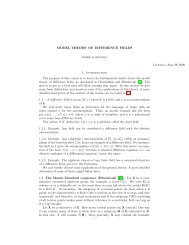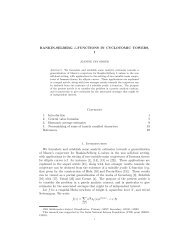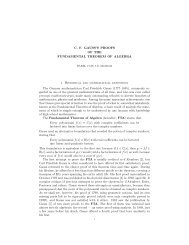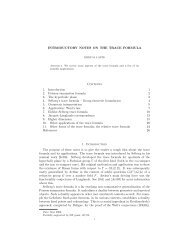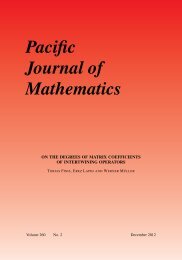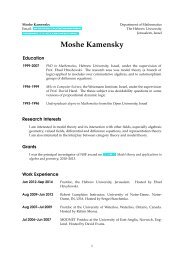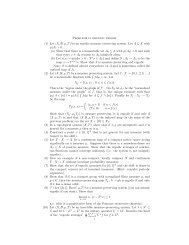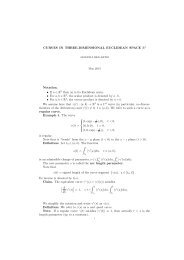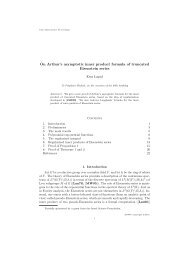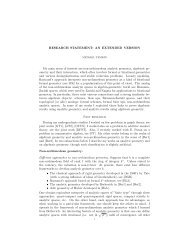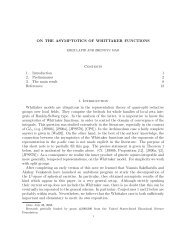<strong>The</strong>re is also a tight connection between embeddings <strong>of</strong> S into a Hilbert space and RKHSs.<strong>The</strong>orem 5.2 A function k : S × S → R is a <strong>kernel</strong> iff there exists a mapping φ : S → Hto some real Hilbert space for which k(x, y) = 〈φ(y), φ(x)〉 H . Also,H k = {f v : v ∈ H}Where f v (x) = 〈v, φ(x)〉 H . <strong>The</strong> mapping v ↦→ f v , restricted to span(φ(S)), is a Hilbert spaceisomorphism.A <strong>kernel</strong> k : S × S → R is called normalized if sup x∈S k(x, x) = 1. Also,<strong>The</strong>orem 5.3 Let k : S × S → R be a <strong>kernel</strong> and let {f n } ∞ n=1 be an orthonormal basis <strong>of</strong> aH k . <strong>The</strong>n, k(x, y) = ∑ ∞n=1 f n(x)f n (y).5.1.2 Unitary Representations <strong>of</strong> Compact GroupsPro<strong>of</strong>s <strong>of</strong> the results stated here can be found in (Folland, 1994), chapter 5. Let G be acompact group. A unitary representation (or just a representation) <strong>of</strong> G is a group homomorphismρ : G → U(H) where U(H) is the class <strong>of</strong> unitary operators over a Hilbert spaceH, such that, for every v ∈ H, the mapping a ↦→ ρ(a)v is continuous.We say that a closed subspace M ⊂ H is invariant (to ρ) if for every a ∈ G, v ∈ M,ρ(a)v ∈ M. We note that if M is invariant then so is M ⊥ . We denote by ρ| M : G → U(M)the restriction <strong>of</strong> ρ to M. That is, ∀a ∈ G, ρ| M (a) = ρ(a)| M . We say that ρ : G → U(H) isreducible if H = M ⊕M ⊥ such that M, M ⊥ are both non zero closed and invariant subspaces<strong>of</strong> H. A basic result is that every representation <strong>of</strong> a compact group is a sum <strong>of</strong> irreduciblerepresentation.<strong>The</strong>orem 5.4 Let ρ : G → U(H) be a representation <strong>of</strong> a compact group G. <strong>The</strong>n, H =⊕ n∈I H n , where every H n is invariant to ρ and ρ| Hn is irreducible.We shall also use the following Lemma.Lemma 5.5 Let G be a compact group, V a finite dimensional vector space and let ρ : G →GL(V ) be a continuous homomorphism <strong>of</strong> groups (here, GL(V ) is the group <strong>of</strong> invertiblelinear operators over V ). <strong>The</strong>n,1. <strong>The</strong>re exists an inner product on V making ρ a unitary representation.2. Moreover, if V has no non-trivial invariant subspaces (here a subspace U ⊂ V is calledinvariant if, ∀a ∈ G, f ∈ U, ρ(a)f ∈ U) then this inner product is unique up to scalarmultiple.17
5.1.3 Harmonic Analysis on the SphereAll the results stated here can be found in (Atkinson and Han, 2012), chapters 1 and2. Denote by O(d) the group <strong>of</strong> unitary operators over R d and by dA the uniformprobability∫measure over O(d) (that is, dA is the unique probability measure satisfyingf(A)dA = ∫f(AB)dA = ∫f(BA)dA for every B ∈ O(d) and every integrableO(d) O(d) O(d)function f : O(d) → C). Denote by dx = dx d−1 the Lebesgue (area) measure over S d−1 andlet L 2 (S d−1 ) := L 2 (S d−1 , dx). Given a measurable set Z ⊆ S d−1 , we sometime denote itsLebesgue measure by |Z|. Also, denote dm =dx the Lebesgue measure, normalized to be|S d−1 |a probability measure.For every n ∈ N 0 , we denote by Y d n the linear space <strong>of</strong> d-variables harmonic (i.e., satisfying∆p = 0) homogeneous polynomials <strong>of</strong> degree n. It holds that( ) ( )d + n − 1 d + n − 3N d,n = dim(Y d n) =−=d − 1 d − 1(2n + d − 2)(n + d − 3)!n!(d − 2)!Denote by P d,n : L 2 (S d−1 ) → Y d n the orthogonal projection onto Y d n.We denote by ρ : O(d) → U(L 2 (S d−1 )) the unitary representation defined byρ(A)f = f ◦ A −1We say that a closed subspace M ⊂ L 2 (S d−1 ) is invariant if it is invariant w.r.t. ρ (that is,∀f ∈ M, A ∈ O(d), f ◦ A ∈ M). We say that an invariant space M is primitive if ρ| M isirreducible.<strong>The</strong>orem 5.6 1. L 2 (S d−1 ) = ⊕ ∞ n=0Y d n.2. <strong>The</strong> primitive finite dimensional subspaces <strong>of</strong> L 2 (S d−1 ) are exactly {Y d n} ∞ n=0.Lemma 5.7 Fix an orthonormal basis Yn,j, d 1 ≤ j ≤ N d,n to Y d n. For every x ∈ S d−1 itholds thatN d,n∑j=1|Y dn,j(x)| 2 = N d,n|S d−1 |5.1.4 Legendre and Chebyshev Polynomials<strong>The</strong> results stated here can be found at (Atkinson and Han, 2012). Fix d ≥ 2. <strong>The</strong> ddimensional Legendre polynomials are the sequence <strong>of</strong> polynomials over [−1, 1] defined bythe recursion formulaP d,n (x) = 2n+d−4xPn+d−3 d,n−1(x) +P d,0 ≡ 1, P d,1 (x) = xn−1n+d−3 P d,n−2(x)We shall make use <strong>of</strong> the following properties <strong>of</strong> the Legendre polynomials.Proposition 5.8 1.(For every d ≥ 2, the)sequence {P d,n } is orthogonal basis <strong>of</strong> theHilbert space L 2 [−1, 1], (1 − x 2 ) d−32 dx .18(8)
- Page 1 and 2: The complexity of learning halfspac
- Page 3 and 4: exists an equivalent inner product
- Page 5 and 6: is enough that we can efficiently c
- Page 7 and 8: our terminology, they considered th
- Page 9 and 10: It is shown in (Birnbaum and Shalev
- Page 11 and 12: We now expand on this brief descrip
- Page 13 and 14: and (uniformly and independently) a
- Page 15 and 16: The proof of Theorem 2.7To prove Th
- Page 17: attempts to prove a quantitative op
- Page 21 and 22: Lemma 5.11 (John’s Lemma) (Matous
- Page 23 and 24: For 1 ≤ i ≤ t Let v i = x i −
- Page 25 and 26: ( )that in this case Err µN ,hinge
- Page 27 and 28: Thus, it is enough to find a neighb
- Page 29 and 30: Legendre polynomials we have|P d,n
- Page 31 and 32: Then, for every K ∈ N, 1 8 > γ >
- Page 33 and 34: Now, it holds that∫∫∫ ∫∫
- Page 35 and 36: We note that ω f◦g ≤ ω f ·
- Page 37 and 38: Now, denote δ = ∫ g. It holds th
- Page 39 and 40: equivalent formulationminErr D,l (f
- Page 41 and 42: Denote ||g|| Hk = C. By Lemma 5.25,
- Page 43 and 44: Consequently, every approximated so
- Page 45: Kosaku Yosida. Functional Analysis.




